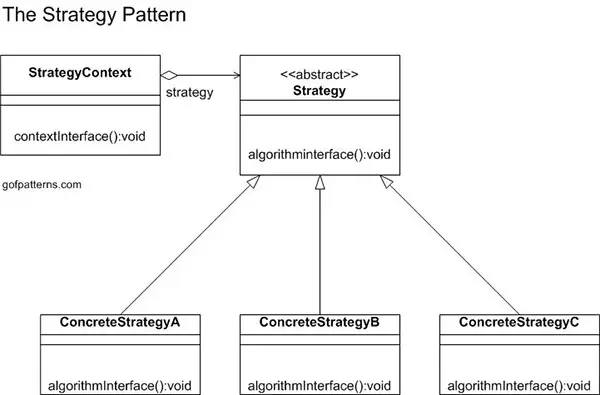The Strategy Pattern: A Comprehensive Overview within Behavioral Design Patterns
In the realm of behavioral design patterns, the primary concern revolves around object collaboration and the delegation of responsibilities. The Strategy Pattern stands out as an instrumental pattern that focuses on defining a family of algorithms, encapsulating each one, and making them interchangeable. This ensures that the algorithm can vary independently from the clients that use it.
- Fundamental Concept of the Strategy Pattern: The Strategy Pattern defines a series of algorithms, encapsulates each one, and makes them interchangeable. The primary objective is to enable a selection mechanism to choose any of the encapsulated algorithms without altering the code that uses the algorithm.
- Key Components:
- Strategy (Interface or Abstract Class): This component defines an interface common to all supported algorithms. Context uses this interface to call the algorithm defined by a ConcreteStrategy.
- ConcreteStrategy: These are classes that implement the algorithm defined by the Strategy. They provide the underlying implementation for the strategy interface.
- Context: The Context maintains a reference to a Strategy object and is furnished with a method for executing the Strategy. The Context may define an interface that lets Strategy access its data.
- Primary Advantages:
- Flexibility: The Strategy Pattern promotes the use of composition over inheritance. Instead of embedding the behavior within the object, the behavior is defined as separate strategies, leading to greater flexibility in assigning behaviors to objects.
- Maintainability: By isolating the algorithm from its clients, any changes to the algorithm or the introduction of new ones have minimal impact on the existing code.
- Avoiding Code Duplication: Multiple classes that differ only in their behavior can share the same strategies, reducing code duplication.
- Practical Implications: Consider an e-commerce platform that offers multiple payment methods like credit card, PayPal, and bank transfer. Instead of hardcoding each payment method into the platform, the Strategy Pattern would encapsulate each payment method as a separate strategy. When a user chooses a payment method, the corresponding strategy is invoked, ensuring a clean and modular approach.
- Positioning within Behavioral Patterns: The essence of behavioral patterns lies in effective communication and responsibility delegation among objects. The Strategy Pattern distinctly addresses the delegation aspect by encapsulating behaviors (algorithms) as separate entities. It shares a conceptual space with patterns like State, but while State is more about an object's behavior changing over its lifecycle, Strategy focuses on making an object's behavior interchangeable.
- Considerations for Implementation:
- While the Strategy Pattern offers robust advantages, it's essential to note that overuse can introduce complexity, as each strategy is a separate class.
- Properly defining the family of algorithms and identifying the aspects that vary is crucial. Over-compartmentalization of strategies can be counterproductive.
The intent of the Strategy Pattern is to define a family of algorithms, encapsulate each algorithm, and make them interchangeable.
The Strategy Pattern lets the algorithm vary independently from clients that use it.
In addition the pattern, defines a group of classes that represent a set of possible behaviors.
These behaviors can then be used in an application to change its functionality.
The figure below illustrates the Strategy pattern.
The figure below illustrates the Strategy pattern.

Class Relationships:
- StrategyContext → Strategy (Composition/Association)
- The
StrategyContextclass maintains a reference (strategy) to an instance of theStrategyclass. - This allows
StrategyContextto delegate the execution of an algorithm to one of the concrete strategy implementations
- The
- Strategy (Abstract Class)
Strategyis an abstract class that defines the interface (algorithmInterface()) which all concrete strategies must implement.- It serves as a blueprint for different algorithm implementations.
- ConcreteStrategyA, ConcreteStrategyB, ConcreteStrategyC (Inheritance)
- These classes inherit from the abstract
Strategyclass. - Each of these classes provides its own implementation of the
algorithmInterface()method. - The
StrategyContextcan dynamically choose among these strategies at runtime.
- These classes inherit from the abstract
Key Characteristics of the Strategy Pattern:
- Encapsulation of algorithms: Different strategies encapsulate different algorithm implementations.
- Interchangeability: The strategy object can be changed dynamically, allowing for flexibility.
- Context-class interaction: The context (
StrategyContext) interacts with aStrategyobject without knowing which specific concrete implementation is used.
Usage Example:
- Sorting algorithms (Bubble Sort, Quick Sort, Merge Sort) where the sorting algorithm can be selected dynamically.
- Payment processing (Credit Card, PayPal, Bitcoin) where each payment method has its own processing logic.
- Compression algorithms (ZIP, RAR, GZIP) where the compression strategy is interchangeable.
This diagram effectively illustrates the Strategy Pattern by showing how a `StrategyContext` delegates work to an abstract `Strategy`, which is implemented by multiple concrete strategy classes. StrategyContext aggregates abstract Strategy class. Three concrete class implementations inherit from abstract Strategy.
Benefits of the Strategy Pattern:
The following lists the benefits of using the Strategy pattern:
- An alternative to subclassing
- Defines each behavior in its own class, which eliminates conditional statements
- Easier to extend a model to incorporate new behaviors without recoding the application
When to Use the Strategy Pattern:
You should use the Strategy pattern when:
- Many related classes differ only in their behavior.
- You need different variants of an algorithm.
- An algorithm uses data unknown to clients.
Strategy Pattern Code